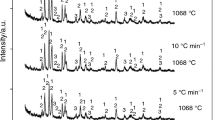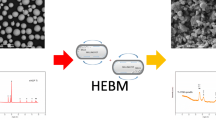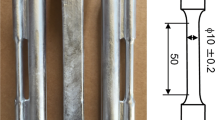Low-temperature sintering of a tetragonal zirconia solid solution proceeds through the fracture of all agglomerates during pressing of samples from hydroxide powder coprecipitated from an aqueous solution and through the increased reactivity of amorphous zirconium hydroxide and oxide. Thermal treatment at 1100°C for 1 h produces ceramics with relative density 0.928, grain size 120–135 nm, and pore size 50–75 nm. Sintering is most intensive in the temperature range 950–1150°C and is less active in the range 800–950°C.




Similar content being viewed by others
References
A. V. Ragulya and V. V. Skorokhod, Consolidated Nanostructured Materials [in Russian], Naukova Dumka, Kiev (2007).
M. Trunec and K. Maca, “Compaction and pressureless sintering of zirconia nanoparticles,” J. Am. Ceram. Soc., 90, 2735–40 (2007).
M. Trunec , K. Maca , and Z. Shen, “Warm pressing of zirconia nanoparticles by the spark plasma sintering technique,” Scr. Mater., 59, 23–26 (2008).
P. Duran, M. Villegas, F. Capel, et al., “Low-temperature sintering and microstructural development of nanocrystalline Y-TZP powder,” J. Europ. Ceram. Soc., 16, 945–952 (1996).
L. Zych and K. Haberko, “Some observations on filter pressing and sintering of yttria-stabilized zirconia nanopowder,” J. Europ. Ceram. Soc., 27, 867–871 (2007).
L. Zych and K. Haberko, “Filter pressing and sintering of a zirconia nanopowder,” J. Europ. Ceram. Soc., 26, 373–378 (2006).
V. Srdic and M. Winterer, “Comparison of nanosized zirconia synthesized by gas and liquid phase methods,” J. Europ. Ceram. Soc., 26, 3145–3151 (2006).
U. Betz, A. Sturm, J. F. Loffler, et al., “Microstructural development during final-stage sintering of nanostructural zirconia-based ceramics,” Mater. Sci. Eng., A281, 68–74 (2000).
S. V. Gabelkov, R. V. Tarasov, N. S. Poltavtsev, et al., “Sintering of tetragonal zirconia,” Vest. NTU KhPI, Thematic Issue: Chemistry, Chemical Technology, and Ecology, No. 39, 136–144 (2008).
S. V. Gabelkov, R. V. Tarasov, N. S. Poltavtsev, et al., “Phase composition evolution of coprecipitated hydroxides of zirconium and yttrium during heat treatment,” Funct. Mater., No. 2, 197–201 (2009).
S. V. Gabelkov, M. S. Poltsavtsev, R. V. Tarasov, et al., Method for Producing Zirconia ceramic Material [in Ukrainian], Ukrainian Patent 79920, C04B 35/48, C01G 25/00, Bulletin No. 11, Publ. December 25 (2007).
Ya. S. Umanskii, Yu. A. Skakov, A. N. Ivanov, and L. N. Rastorguev, Crystallography, X-Ray Diffraction, and Electron Microscopy [in Russian], Metallurgiya, Moscow (1982).
G. Teufer, “The crystal structure of tetragonal ZrO2,” Acta Crystallogr., No. 15, 1187–1189 (1962).
S. V. Gabelkov and R. V. Tarasov, “Structural evolution of nanosized xerogel of zirconium hydroxide during grinding and pressing,” Fiz. Tekh. Vys. Davl., No. 3, 94–110 (2009).
S. V. Gabelkov, R. V. Tarasov, A. G. Mironova, and L. M. Litvinenko, “Structural evolution of xerogel in producing nanosized zirconia powder,” in: Nanosystems, Nanomaterials, Nanotechnologies (Collected Scientific Papers) [in Russian], Vol. 6, Issue 4, 1315–1330 (2008).
S. V. Gabelkov, R. V. Tarasov, A. G. Mironova, and L. M. Litvinenko, “Structural evolution of nanosized zirconia powder during grinding and pressing,” Fiz. Tekh. Vys. Davl., 18, No. 2, 98–110 (2008).
Author information
Authors and Affiliations
Corresponding author
Additional information
Translated from Poroshkovaya Metallurgiya, Translated from Poroshkovaya Metallurgiya, Vol. 50, No. 5–6 (479), pp. 113–121, 2011.
Rights and permissions
About this article
Cite this article
Gabelkov, S.V., Tarasov, R.V., Poltavtsev, N.S. et al. Low-temperature sintering of yttria-stabilized zirconia produced from amorphous powders. Powder Metall Met Ceram 50, 338–344 (2011). https://doi.org/10.1007/s11106-011-9337-6
Received:
Published:
Issue Date:
DOI: https://doi.org/10.1007/s11106-011-9337-6




